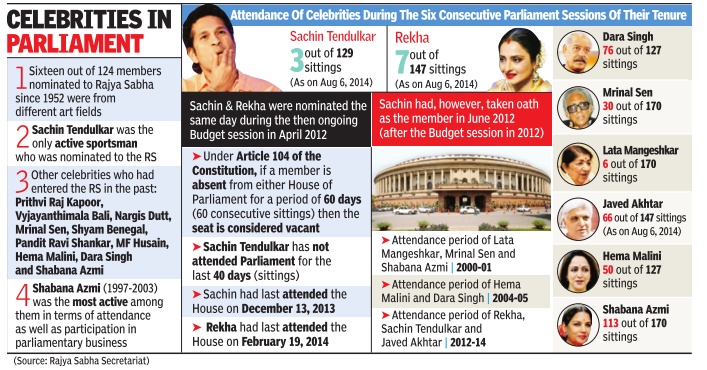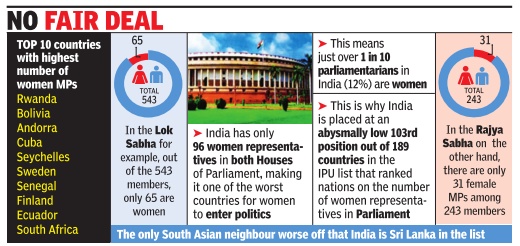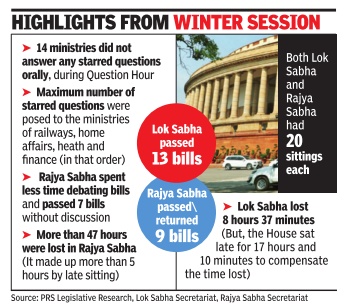Parliament: India (general issues)

This is a collection of articles archived for the excellence of their content.
|
This page deals with issues and factoids common to the two houses of Parliament, the Rajya Sabha as well as the Lok Sabha
Non-political celebrity MPs
Celebrities in the Indian parliament

Non-political celebrities in the Indian parliament belong to two main streams:
i) Those who win elections and enter the Lok Sabha, and
ii) Those who are nominated to the Rajya Sabha under the special dispensation allowed for such nomination.
There are two more categories:
iii) Those who get elected to the Rajya Sabha; and
iv) Those who, after initial nomination to the Rajya Sabha later feel confident enough to seek election to the Lok Sabha, and win.
Celebrity MPs' attendance in Parliament
Celebrity MPs are a rare sight in House Vishwa.Mohan@timesgroup.com New Delhi: The Times of India Jul 21 2014

Sachin Attended 3 Days, Rekha 7 Since April ’12
Celebrity MPs simply give a royal miss to Rajya Sabha, the upper House of Parliament, where they find place as ‘nominated’ members due to their outstanding performance in their respective professions.
Be it legendary singer Lata Mangeshkar or the late painter M F Husain in the past or cricketer Sachin Tendulkar and Bollywood actress Rekha now, the ‘nominated’ celebrity MP has not matched up to the other nominated members, who come from professions like academics, civil services, journalism, legal service or science.
Records show that Tendulkar has attended the House only thrice while Rekha has attended it on seven days since they were nominated as MPs in April 2012.
Though Tendulkar was expected to attend the House more often once he retired from international cricket, he did so only once after November last year. The upper House sat for 35 days during three sessions between December 2013 and July this year.
Neither Rekha nor Tendulkar attended any sittings during the ongoing session of Parliament under the new government. Their absence from the House was noted by other members. Last week, RJD member and former Union minister Premchand Gupta referred to it in the House and questioned such nominations.
Besides Rekha and Tendulkar, poet-lyricist Javed Akhtar is the other celebrity among the 12 nominated members. Though Akhtar's record is much better, he re mains a mute spectator during most of the proceedings. He was last heard during a debate on amending the Copyright Bill two years ago.
His wife Shabana Azmi was, in contrast, among the most vocal celebrities who raised many issues and actively participated in many debates during her tenure.
Records show that the other nine nominated members, including businesswoman and social activist Anu Aga, journalist H K Dua, theatre personality B Jayashree, jurist K Parasaran and lawyer K T S Tulsi, have been quite regular in Parliament.
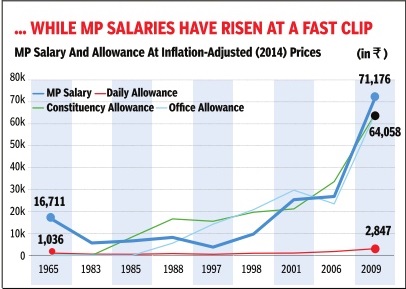
Utilisation of MPLADS funds
Sachin Tendulkar, Rekha spent nothing from MP development fund
TNN | Feb 24, 2014 The Times of India
NEW DELHI: Cricket superstar Sachin Tendulkar and veteran actress Rekha who were nominated to Rajya Sabha around two years ago have spent "zero" rupee on development in their respective adopted areas.
Official reports published on the website of ministry of statistics and programme implementation reveal that the celebrity MPs did not spend anything from their members of the parliament local area development (MPLAD) fund.
The Upper House parliamentarians get to adopt a district of their choice for development. Each Rajya Sabha member is entitled to Rs 5 crore a year from their MPLAD fund. Sachin Tendulkar adopted district is Mumbai suburban, but Rekha has not bothered to even adopt a district.
Neither sent any development project proposal to the government. Both have accumulated Rs 10 crore each in their two year old accounts.
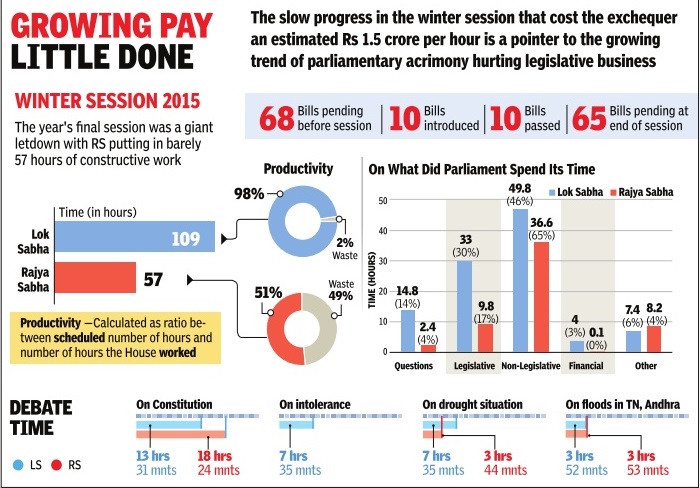
The whip
Origin of ‘whip’
Whip governs expelled legislators
The Times of India, Aug 04 2016
Dhananjay Mahapatra
The Supreme Court refused to answer questions raised by expelled MPs Amar Singh, Jaya Prada and Pyari Mohan Mohapatra, leading to revival of its 1996 judgment making elected representatives thrown out of a party amenable to the party whip in a House. The SC had on November 15, 2010 passed an 11-page judgment staying application of its 1996 judgment to Amar Singh and Jaya Prada, who were expelled from Samajwadi Party on January 6, 2010.
It had referred the matter to a three-judge bench after framing seven questions for consideration, including whether an expelled MP or MLA would come under the ambit of party whip and whether defiance of such whip would make the elected representative liable to disqualification proceedings under the Tenth Schedule. Expelled from BJD in 2012, Mohapatra had moved the SC and got relief similar to Singh and Jaya Prada.
A bench of Justices Ranjan Gogoi, Arun Mishra and P C Pant, which had heard detailed arguments on the seven questions and reserved the verdict on February 15, on Wednesday surprised the counsel for the three petitioners by saying, “We are not answering the questions raised in the petitions.“
The bench passed a short order saying the term of these elected representatives had ended and the petitions had become infructuous.
In comparison, the reference judgment of November 15, 2010 by Justices Altamas Kabir and Cyriac Joseph dealt elaborately with the pleadings and had said, “Pending the refe rence, the decision in G Vishwanathan's case (the 1996 judgment) shall not apply to Amar Singh and Jaya Prada.“
With this order, the 1996 judgment will apply to all expelled MPs and MLAs immediately and they will have to adhere to the whip issued by the party on whose ticket they were elected to the House before being expelled.
Justices Kabir and Joseph had said, “We are convinced that the decision in G Vishwanathan's case merits another look as far as members of the House who are expelled from their parties on whose banner they had been elected to the House are concerned, as they would be left completely vulnerable to the whims and fancies of the leaders of their parties.“
Women in Parliament
2014-16: Participation of women
The Times of India, Mar 8, 2016
Anahita Mukherji
Women in House: India's rank slips
The 16th Lok Sabha may have the highest number of women that the Lower House has ever had, but India has slipped from a rank of 117 among 188 countries in 2014 to 144 among 191 countries as on February 1, 2016, in terms of the proportion of women in Parliament.
Barely 12% of MPs in the Lok Sabha are women and the figure stands at 12.8% in Rajya Sabha. This is well below the global average of around 22% in both Houses.
President Pranab Mukherjee had made a strong pitch for reviving the Constitution amendment Bill to give 33% reservation to women in Parliament. While 62 women were elected to the Lok Sabha in the general elections in May 2014, four more have been added over the last couple of years through by-elections. But while the proportion of women has increased from 11.4% in June 2014 to 12% in February 2016, India's rank compared to other countries has fallen. Countries that currently rank higher than India include several African and Latin American countries, as well as countries that were part of the erstwhile Soviet Bloc. Rwanda ranks No 1 with 63.8% women in the lower house of parliament and 38.5% in the upper house.
"Equality is a core value in the Indian constitution. Why are women being kept out of Parliament? Why are women excluded from party lists at the time of elections? One cannot say that women lack merit," said CPM leader Brinda Karat, who has actively campaigned for the women's reservation bill. "The bill has been absent in business agendas for the last two years. Instead, what we have is the worst kind of tokenism, with the PM calling for only women MPs to speak on March 8," she added.
India no. 103 in women's representation
India no country for women netas
Kounteya Sinha The Times of India Mar 06 2015 London
At 103, India Behind Sub-Saharan Africa In Representation Of Fairer Sex In Parliament
India has been found to be one of the world's worst countries for women to enter politics. Data shows that even countries like Syria, Rwanda, Sierra Leone, Niger and Somalia have more women in their parliament. Days before the world celebrates the International Women's Day , the Inter-Parliamentary Union (IPU) revealed that there are only 96 women representatives in both houses of Parliament in India. The country , therefore, ranks abysmally low -103rd -in the Women in Parliament study released.
The worst country in the world for woman parliamentarians is Vanuatu, ranked 137th, where not a single woman is in parliament.
India, where only 12% of parliamentarians are women in both houses of parliament -65 in the Lower House and 31 in the Upper House -can learn from its immediate neighbours. Pakistan -having 84 woman parliamentarians -ranks 64th with 21% legislators in its lower House and 17% in the upper House being women. China, too, is much better off. It ranks 53rd with 699 members in its lower House being women (24%).
Nepal, which is ranked as high as 35, is a shining example of how to involve more women in parliament. Almost every third seat in Nepal's parliament -totalling around 176 -are occupied by women.
Not just these, even Afghanistan beats India by miles. The country is ranked 39th and boasts of 97 women parliamentarians -28% of seats in both its houses. In Bangladesh, too, every fifth parliamentarian is a woman (20%).
The IPU said, “There were also minor increases to both houses of Parliament in India, though the overall percentage remains very low.“
The US is ranked 72nd with 84 woman parliamentarians in its lower House (20%) and 20 in the upper House.The UK, on the other hand, is ranked 56th with 24% of parliamentary seats in the upper House taken by women and 23% in the lower House. There is, however, good news globally . The number of single or lower houses of parliament where women occupy more than 30% of the seats increased from five to 42, while those with more than 40% have jumped from one to 13 over the past five years.There are now also four chambers with more than 50% women MPs and one, Rwanda, with more than 60%.
In 1995, Europe dominated the top 10 spots in the IPU's world rankings of women in parliament. In 2015, four of the top 10 countries are from Sub-Saharan Africa.
Only Finland, Seychelles and Sweden appear in the top 10 for both 1995 and 2015, while Rwanda, Andorra and Bolivia have made the biggest leaps forward.
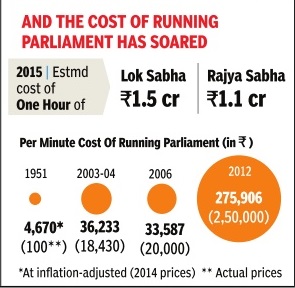
Members of Parliment
Indifferent MPs
Sachin Tendulkar adopted a district is Mumbai suburban, but Rekha has not bothered to even adopt a district as Rajya Sabha MP.
Expulsion of MPs
The Times of India, Apr 28 2016
Mallya could be 15th MP to be expelled
If Vijay Mallya is expelled from Parliament, he will be the 15th MP to meet such a fate. Fo urteen MPs, in cluding one for over a year, have been expelled from Parliament (Rajya Sabha and Lok Sabha) since 1951.
These 14 MPs include Subramanian Swamy , who took oath as Rajya Sabha member, and former PM Indira Gandhi, who was expelled from Lok Sabha in November 1977 but her motion of expulsion was later rescinded by the House.
Indira was expelled for obstruction, intimidation, harassment and instituting false cases against certain officials, who were collecting information to answer a question in the House.
Swamy was expelled from Rajya Sabha in 1976 after a parliamentary panel found his conduct derogatory to the dignity of the House.Then Lok Sabha member HG Mudgal was the first to be expelled from the lower House in 1951. He was expelled for accepting money for favours in Parliament.
Eleven MPs, including one from RS, were expelled in 2006 after the `cash-for query' sting operation by a private TV channel in 2005.
Expulsion of Mallya was suggested by the ethics committee of Rajya Sabha, headed by veteran Congress member Karan Singh, last week. The panel, however, decided to give Mallya a week to explain his conduct, which the members said was a “procedural formality“.
Private member’s bills

Apr 25 2015
Just 14 private member's bills passed by Parliament till date; the last was in 1970
Only 14 private member's bill have been passed by both Houses and become law in the history of Indian Parliament. The last such bill, the Supreme Court (enlargement of criminal appellate jurisdiction) Bill, was passed in 1970. Members of Parliament other than ministers are called private members and bills presented by them are known as private member's bills.
An overwhelming number of such bills are introduced with only a fraction even discussed on the floor of the House. According to data collated by PRS Legislative Research in the 13th Lok Sabha, 343 such bills were introduced but only 17 were discussed while only 14 of the 328 bills were discussed in the 14th LS. In the last LS, 372 bills were introduced by members but 11 were discussed while in the present (16th Lok Sabha) 206 bills have been introduced and six have been discussed excluding the bill on transgenders introduced on Friday .
Among the bills that were introduced on Friday was one which seeks to set targets for reduction of greenhouse gas emissions to address climate change, another to prevent, control and manage the HIVAIDS epidemic, yet another to establish a fodder warehouse board, a national commission for famers and amendments to protection of children from sexual offences act among others.
“No private member's bill has become law since 1970,“ Subhash Kashyap, expert in parliamentary affairs said.
Among the 14 bills that have become law in the past and were introduced in the Lok Sabha were the Muslim Wakfs Bill as early as 1952 that provided for better governance and administration of Muslim Wakfs, the Code of Criminal Procedure (Amendment) Bill in 1953 that aimed to empower the revisional court to stay or suspend the final orders of lower courts and the Indian Registration (Amendment) Bill, 1955 which sought to remove the anomaly of recording castes and sub-castes of parties in a deed for registration.
Others include the Proceedings of Legislature (Protection of Publication) Bill, 1956, brought by Feroze Gandhi in the Lok Sabha to protect journalists reporting on Parliament proceedings and to define by law the privilege available to publications made in good faith of reports of proceedings of legislatures, the Women's and Children's Institutions (Licensing) Bill, 1954, introduced by Rajmata Kamlendu Mati Shah and passed in 1956 to regulate and license orphanages and other institutions caring for women and children under 18 years of age and to provide for the proper custody , care and training of their inmates.
The Ancient and Historical Monuments and Archaeological Sites and Remains (Declaration of National Importance) Bill, 1954 was introduced in the Rajya Sabha by Raghubir Singh and aimed to get certain monuments included in the list of Monuments of National Importance declared in the principal Act of 1951.
The Hindu Marriage (Amendment) Bill in 1956 brought by Seeta Parmanand in RS and passed in 1956 said that when both parties belong to the Hindu religion and are marrying under the Special Marriage Act, they will be governed by the Hindu Succession Act, 1956.
The Code of Criminal Procedure (Amendment) Bill, 1957, the Orphanages and Other Charitable Homes (Supervision and Control) Bill, 1960, the Marine Insurance Bill, 1959, the Hindu Marriage (Amendment) Bill, 1962, the Salaries and Allowances of Members of Parliament (Amendment) Bill, 1964 and the Indian Penal Code (amendment) bill, 1963, passed in 1969 were also some bills passed by both Houses.

Parliament attack: 2001
India Today December 29, 2008
December 13, 2001, saw an audacious terror attack on Parliament which the intelligence agencies had no clue about. “The attack on Parliament was reality television at its horrific best, September 11 and the World Trade Centre translated into Indian idiom,” said India Today in December 2001. The elaborate terror plot was hatched for eight months by the terror organisation in Pakistan and their local modules in Delhi and Kashmir.
Legislative work, laws enacted
1952-2017: trends
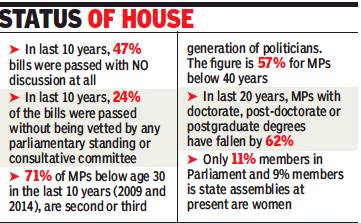
From: Mohua Chatterjee, ‘47% of bills in last 10 yrs passed without debate’, December 11, 2017: The Times of India
At a time when a delayed schedule for the winter session of Parliament in 2017 is a matter of discussion in political circles, an examination of records shows that 47% of bills in the last10 years were passed without any debate.
There has also been a steady reduction in parliamentary hours, a comparison with records of the first 20 years since 1952 show. Between 1952 and 1972, the House ran for between 128 and 132 days a year, according to parliamentary sources. In thelast10 years, it ran for 64to 67 days a year on an average.
Parliament passing a good number of legislations without any debateisin itself an abuse of the parliamentary system. Records show that 47 % bills in the last 10 years were passed with no discussion at all. Sixty-one per cent of these (24% in all) were passed in the last three hours of a session.
In the last 10 years, 31% of legislations were passed in Parliament with no scrutiny or vetting by any parliamentary standing or consultative committee. However, there is no mandatory requirement to refer billstocommittees.
Another alarming trend is the decline in standards of educational qualifications of lawmakers in thelast20 years. To make matters worse, while educational qualifications of MPs have fallen, there has been a consistent demand by them for hike in their own salaries. The number of MPs with doctorate, post-doctorate and post-graduatedegreeshas declined by 62% in the last 20 years, recordsshow.
Asfor thedebateon dynastic politics, exceptions seem to be few in number, especially among the youthbrigadein Parliament. In the last 10 years, 71% MPs below the age of 30 were second or third generation parliamentarians and among those below 40 years, 57% had similar credentials.
Interestingly, salaries of MPs were increased four times in the last five years.
2004- 2018, Monsoon sessions

From: Akhilesh Singh, LS churns out most productive monsoon session since 2000, August 11, 2018: The Times of India
Lower House Sat For 110% Of Scheduled Time
With the government agreeing to the contentious no-confidence motion moved by the Telugu Desam
Party early on, the Lok Sabha saw the most productive monsoon session since 2000, one that ended on Friday with the passage of amendments to the law that empowered homebuyers in insolvency cases.
The amendments seek to replace the June 6 ordinance that places homebuyers as “financial creditors” on a par with banks. Data compiled by PRS Legislative Research shows that 18 of 20 bills introduced during the session were passed. The LS worked for 110% of the scheduled hours and the Rajya Sabha for 66%.
Lok Sabha sat for 20hrs beyond scheduled time to make up for 8hrs lost in disruptions
The Lok Sabha and the Rajya Sabha spent 50% and 48% of their time on legislative business, respectively, the data said. This is the highest by both Houses in the 16th Lok Sabha and the second-highest since 2004.
Among significant legislations, granting constitutional status to the National Commission for Backward Classes and restoring the immediate arrest provision in the SC/ST Act are a major political gain for the ruling party, which has been facing flak on Dalit issues.
Fewer bills (26%) were referred to parliamentary committees as compared to the 15th Lok Sabha (71%) and the 14th Lok Sabha (60%) — a fallout of the Modi government’s big majority. The Lok Sabha sat for over 20 hours beyond the scheduled time to make up for over eight hours lost in disruptions.
The session has also been one of the most productive for question hours in the 16th Lok Sabha. The Lok Sabha and the Rajya Sabha functioned for 84% and 68% of their scheduled question hour time. As many as 999 private member bills, the most since 2000, were introduced, PRS said.
In the 16th Lok Sabha, so far the most government bills have been introduced by the ministry of law and justice and the ministry of health and family welfare.
In the 15th Lok Sabha, the highest number of bills were introduced by the ministry of finance, ministry of home affairs and ministry of law and justice. “I have several times laid stress on the conduct of the House which is essential to maintain credibility of Parliament,” Lok Sabha Speaker Sumitra Mahajan said after she adjourned the House sine die on Friday. “The session was more productive and satisfactory compared to the past two other productive sessions — the second part of budget session 2017 and the last monsoon session,” she said.
Rajya Sabha chairperson M Venkaiah Naidu said the session proved to be about three times more productive than the budget session whose productivity was only about 25%. “This is a remarkable improvement and the credit goes to all,” he said.
The House discussed the supplementary demands for grants (general) and demands for excess grants (general) for 2015-16 and the approved the relevant appropriation bills.
2009-14, 2014- July 16
The Times of India, Aug 10 2016
Himanshi Dhawan
The 16th Lok Sabha has passed 109 bills while Parliament has passed 97 bills since the budget session of 2014 with the Modi government at the helm. In comparison, Parliament passed 179 bills -116 legislative bills and 63 finance and appropriation bills-during 2009-2014 when UPAII was in power.
While respon ding to the debate on GST in Lok Sabha, PM Narendra Modi said while his government was over 100 weeks old, the lower House had cleared over 100 bills and hit a “century.
“This is the strength of this House and this is what has given citizens a new confidence, he said while extolling the political consensus that was arrived at with all political parties, except AIADMK, expressing support for the 122nd Constitutional Amendment Bill (GST).
Of the bills passed by both Houses were 70 legislative bills and 27 finance and appropriation bills, according to data collected by PRS Legislative Research. Among the highest number of laws passed in the last two years were in the budget session, 2016 when 24 bills were cleared of which 16 were legislative and 8 finance bills. So far in this monsoon session, Parliament has passed 12 bills.
“The number of bills passed by Parliament cannot be the only criteria of its legislative work. What should also be taken into account is the debate and scrutiny that bills receive while being passed by Parliament. Some bills of the 16th Lok Sabha have not been referred to standing committee, and some others have been passed without adequate debate in the house, Chakshu Roy , head of outreach at PRS Legislative said hitting a note of caution.
One of the significant bills that was cleared by both Houses with scant discussion was the Lokpal and Lokayukta Amendment Bill.The bill dropped the controversial Section 44 excluding spouse and kids of public servants from disclosure of their wealth.
2015
Suspension of members
Rule 374(A): MPs suspended if named
The Times of India, August 4, 2015

Lok Sabha Speaker Sumitra Majahan invoked Rule 374(A) to name (identifying for action) 25 Congress members who were in protesting in the well of the House. Rule 374(A) says, “Notwithstanding anything contained in Rules 373 and 374, in the event of grave disorder occasioned by a member coming into the well of the House or abusing the Rules of the House, persistently and willfully obstructing its business by shouting slogans or otherwise, such member shall, on being named by the Speaker, stand automatically suspended from the service of the House for five consecutive sittings or the remainder of the session, whichever is less“.
Winter 2015: Majority of time spent on non-legislative business
The Times of India Dec 24 2015
The winter session of Parliament that ended once again reflected how the productivity of Rajya Sabha, where proceedings were marked by frequent disruptions, remained just about 50%. Urging MPs to introspect, chairman Hamid Ansari said the record belied the House's commitment to Constitutional principles “in good measure“.
Against this, Lok Sabha logged productivity of 102%, passing more bills and spend ing more time in debating those legislations.
Ever since BJP-led NDA came to office, the oppositioncontrolled Rajya Sabha has been lagging behind in the past four sessions. Similar fig ures appeared during the monsoon session (July-August) during which Rajya Sabha registered a virtual washout, seen as its worst performance (9%). Over the years, the pro ductivity of Lok Sab ha and Rajya Sabha has been similar, with a few instances of one House performing marginally better than the other. However, in the last four sessions, the average productivity of Lok Sabha has been 97% and the average productivity of Rajya Sabha has been 62%,“ said the PRS Legislative Research in its analysis soon after the session ended on Wednesday .
The productivity gap between the Houses appeared to be getting pronounced since last year's winter session when Lok Sabha's overall productivity was 98% as compared to 59% of Rajya Sabha.This year's Budget session was an exception, with both Houses performing well.
An upset Ansari said the interruptions in the functioning of the House were “sought to be justified by specious logic by different sections of the House at different times to suit their tactics of the moment“, leading to loss of working time and neglect of listed business.
The PRS Legislative Research noted that the majority of the productive time during the winter session was spent on non-legislative business, which included discussions on issues related to price rise, drought and floods, and a two-day special sitting on reaffirming commitment to the principles and ideals of the Constitution.
The Times of India (Delhi)
2016
2016: 100% work in monsoon session
The Times of India, Aug 13 2016
LS, RS score 100% biz in monsoon session
Parliament functioned overtime in the monsoon session with Lok Sabha working for 110.84% and Rajya Sabha for 99.54% of their scheduled time, according to the figures shared by the government.
During the session, 15 bills were introduced. While the Lok Sabha passed all 15, Rajya Sabha gave its nod to 14, including a constitutional amendment bill enabling the levy of Goods and Services Tax (GST).
Some bills that were introduced and passed on the same day included Lokpal and Lokayuktas (Amendment) Bill, which was passed in less than half an hour in each House, Taxation Laws (Amendment) Bill and the Maternity Benefits (Amendment) Bill.
Another analysis by PRS Legislative Research, however, said that during this session, Rajya Sabha met for 96% and Lok Sabha for 101% of their scheduled time.This implies that lesser time was lost to disruptions.
During the session, both Houses sat for extra hours on most days. Out of 20 days, Lok Sabha sat beyond its scheduled time on 11 days, while Rajya Sabha sat beyond its scheduled time on 14 days.
Question hour was one of the most productive since 2004. During the session, 25% (98) of the questions were answered in Lok Sabha, while 28% (84) of the questions were answered in Rajya Sabha.
Question Hour in Lok Sabha functioned for 88% of its scheduled time, while in Rajya Sabha it functioned for 69% of its scheduled time.
Rajya Sabha spent 52% of its time, and Lok Sabha 40% of its time on discussing issues such as inflation, and atrocities against Dalits. The recent incidents in Kashmir were debated for a total of 16 hours in both the Houses.
Two bills replacing ordinances, the Indian Medical Council (Amendment) Ordinance, 2016 and the Dentists (Amendment) Ordinance, 2016, which were promulgated by the President, were considered and passed by both Houses in this session.
Agricultural University: Bill passed in single day
The Times of India, May 13 2016
Vishwa Mohan
In rarest of rare case, both LS, RS pass bill in one day
Bihar Gets A Central Agri University
In what could possibly be a rare example of a legislation being passed by both Houses on the same day ,Rajya Sabha and Lok Sabha passed the Rajendra Prasad Central Agricultural University Bill. Even President Pranab Mukherjee gave his assent to it the same day -making it a rarest of the rare case in parliamentary history .
The legislation, meant for upgrading the existing Rajendra Agriculture University (RAU), Pusa, in Bihar's Samastipur district as a central university , gave the state its first central agriculture university . “The central agriculture university is a big gift for the people of Bihar. It has fulfilled their long pending de mand,“ said agriculture minister Radha Mohan Singh. Bihar, which happens to be the minister's home state, recently got the Mahatma Gandhi Central University in Motihari. Singh told TOI, “It is an honour to the state which got two central universities, including one central agriculture university, in the name of two great men -Mahatma Gandhi and Rajendra Prasad.“ “Passing of a bill by both Houses of Parliament on the same day can be done by waiving of rules (like giving minimum time to members of the other House to vet it through prior notice). After all, the House is the master of the bill. If a House decides to take up a particular bill the same day , it can take it up,“ said PDT Achary , Constitution expert and former Lok Sabha secretary general. Asked by TOI to recall any other such instance, Achary said that though a couple of bills might have been passed in similar fashion in the past, he could not recollect any such case in the recent past.
The bill was first passed by Rajya Sabha and hours later, Lok Sabha also approved it unanimously without any discussion.
Since the Lower House was to adjourn sine die on Wednesday itself, the minister was keen to get it approved. The bill was introduced in the Upper House in December, 2016.
2016: April- May
The Times of India, May 11 2016
LS records 120% productivity, RS 84%
Himanshi Dhawan
Despite deep fissures emerging between BJP and Congress over the AgustaWestland defence deal, Parliament suffered limited damage with Lok Sabha working overtime recording 120% productivity , while Rajya Sabha recorded 84%. LS had an unblemished record in conducting question hour so far with 100% productivi ty while question hour functioned 63% of the time in RS.
This is just a shade lower than the budget session 2016 when LS functioned 121% of the time and RS for 96%, according to analysis by PRS Legislative Research.
The Lower House worked for 79.10 hours, though it had allocated 66 hours for this session. RS lost 16% of its time working for 54.58 hours instead of the 65 hours allocated. Members listed 220 questions for a response in Lok Sabha of which 63 that is 29% were answered while in Rajya Sabha 46 of the 165 listed questions were answered orally.
While both Houses have had similar productivity figures, in recent times disruptions and adjournments have been more frequently seen in the Upper House where the ruling party has lower numbers. Among the significant is sues that were taken up were the AgustaWestland case which was taken up by known Gandhi family baiter Subramanian Swamy in his debut speech. This was followed by a fractious debate and defence minister Manohar Parikkar's reply in which he assured that action will be taken and Bofors would not be repeated.
Lok Sabha members discussed the water crisis and drought affecting large parts of the country and both Houses held discussions on the working of ministries of finance, human resource development, civil aviation and tourism.
Among the important legislations that have been passed by both Houses include the Anti-hijacking (Amendment) Bill, Sikh Gurdwara (Amendment) Bill and Constitution (Scheduled Caste) Amendment Bill, Mines and Minerals (Development and Regulation) Amendment Bill and Appropriation Bill 2016. Data for this session is till May 9. The session is expected to continue till May 13.
2017-18
Winter: RS lost 33 hours to disruptions, LS 15
RS lost 33 hours to disruptions, Lok Sabha 15, January 6, 2018: The Times of India
Rajya Sabha chairman Venkaiah Naidu regretted substantial loss of functional time on account of frequent disruptions in the House, and urged members to introspect as the winter session of Parliament ended on Friday.
RS was adjourned sine die without taking up the triple talaq bill for lack of consensus over the opposition’s demand to refer it to a select committee.
“..Though Parliament is a political institution, it cannot be an extension of politics in its typical sense ... It is unfortunate that despite discharging its responsibilities to a great extent, the august House ends up losing some degree of esteem of the people on account of disruptions and substantial loss of time...,” Naidu said while thanking MPs for passage of nine bills.
In the beginning of the session, insistence by Congress for an apology from PM Modi for his remark against Manmohan Singh led to disruptions.
A review of proceedings reveals that a total 41 hours of business was transacted while over 33 hours were lost to disruptions over 13 sittings. Apart from nine government bills, 19 private members’ bills were introduced. The Upper House even created a record on January 2 by taking up all starred questions after a gap of 15 years.
Passage of the triple talaq bill was the highlight in Lok Sabha, which passed 12 bills and held 13 sittings spread over 61 hours and 48 minutes and lost about 15 hours due to disruptions.
The LS passed several key bills during the session including those for raising the salaries of judges, central road fund (amendment) bill, the requisitioning and acquisition of immovable property bill, the national capital territory of Delhi laws (special provisions) second (amendment) bill and the goods and services tax (compensation to states) amendment bill.
2018
Budget session: productivity less than 10% of average
Rumu Banerjee, House productivity less than 10% of average, March 20, 2018: The Times of India

From: Rumu Banerjee, House productivity less than 10% of average, March 20, 2018: The Times of India
Two weeks into the month-long session of Parliament and it’s making news for all the wrong reasons. An analysis of the hours spent by members of Parliament in both Houses, the Lok Sabha and the Rajya Sabha, shows that productivity is less than 10% on average. There were days when less than 3% of the allotted time was used for legislation.
As per the analysis of actual sitting hours, since March 5, when the second part of the Budget session started, till March 16, the maximum work done in the Lower House of Parliament, was on March 14, when members of Parliament spent 42 minutes in the House. That was the day when Appropriations Bill and the Finance Bill were passed by the Lok Sabha, without discussion.
In the Upper House, the maximum sitting by MPs was for one hour on March 8. The reason why the session went on so long was due to Women’s Day, with members speaking on the delay regarding the women’s bill as well as the strides made by women in the country.
The scheduled number of working hours in both Houses is around six hours, says PRS, which conducted the work-hour analysis.
In the Lok Sabha though, it has mostly been disruptions, with actual work taking up 12 to 30 minutes on most days. The least amount spent on legislation was on March 7 by the Upper House — it spent only 9 minutes. The hours lost every day in the Lok Sabha has been over five hours daily.
The Rajya Sabha has not fared any better. Hours lost hover between 4.97 hours to 5.82 hours as most sessions have been adjourned. On most days the number of sitting hours have ranged between 11minutes to half hour.
Not surprisingly, therefore, the amount of productive hours lost is a huge 90% in both the Houses through the past two weeks.
A result of the minuscule number of hours spent in legislation has been the passage of bills without discussion, like the Union Budget 2018, which didn’t see any discussion. Amendments, like the one allowing political parties to be exempt from scrutiny for funds received from abroad, are other casualties of the incessant adjournments.
Monsoon session: 1st no-confidence motion in Parliament in 15 years, 39 MPs spoke for almost 12 hours
July 21, 2018: The Times of India
Rahul Creates Flutter, Modi Has Last Word
In the first no-confidence motion in Parliament in 15 years, 39 MPs spoke for almost 12 hours, but at the end of the day, all eyes were on the face-off between the Congress president and the PM. The govt sailed through with a bigger margin than expected, but with LS elections looming, the drama has just begun
NDA Wins 325-126 With AIADMK Backing And BJD, TRS Abstentions
Marked by moments of high drama and histrionics, the no-confidence debate in Lok Sabha saw Prime Minister Narendra Modi capitalising on Rahul Gandhi’s surprise hug to suggest that the Congress chief’s gesture asking him to get up only reflected an unfounded eagerness to assume the high office.
“Those who want to reach here in a hurry came here and gestured ‘get up, get up’,” Modi said. Gesturing with his hands, he mimicked Rahul’s actions, providing more drama to a 12-hour debate that ended with BJP winning the vote by a large margin, its numbers swelling to 325 with 451 votes cast. The opposition scored a sub-par result with its tally reaching 126 as TRS and BJD walked out. The surprise abstention of Shiv Sena was more than made up by the support of AIADMK.
A combative PM said he would like the opposition to bring another no-confidence motion against him in 2024, implying that BJP was well on its way to returning to office in the Lok Sabha elections next year. He lashed out at Congress, saying its arguments during the no-confidence motion reflected a “deep lack of confidence in itself ”.
Gandhi had ended his speech by walking across to the PM. When Modi did not rise from his seat, he reached down and hugged him. As he walked away, Modi called him back to shake his hand and pat him on his back, even as MPs watched, most of them taken aback.
“Congress has no confidence in itself. It has no belief in Swachh Bharat, in international yoga day, the Chief Justice of India, Reserve Bank of India, the official agency that compiles national data, the rising value of Indian passport, the Election Commission, electronic voting machines... not even in itself,” he said.
Its lack of confidence was leading Congress to create uncertainty and instability, said the PM. “If you don’t believe in people, you will find
yourself on the run. In a democracy, the people are the ‘bhagya vidhata (makers of destiny)’,” he said. Taking yet another dig at Rahul, he said it wasn’t good enough to say ‘I will be PM as Congress is the biggest party’, others have to say so too.
Modi also responded to Rahul’s jibe that he couldn’t look him in the eye over allegations of corruption in the Rafale deal, saying, “How can I have the courage to do so... a son of a poor mother, who was born in a family of modest means.” He drove the point home, saying the Congress’s first family considered the post to be its preserve.
Parliament canteen
2016: No subsidy, no-profit
The Times of India Jan 01 2016
Food items served in Parliament canteen will be dearer from Friday , with rates being revised in varying degrees in the wake of controversies over hugely subsidised costs of eatables in times of ballooning prices.
With the canteen working on `no-profit, no-loss' basis, a vegetarian platter which earlier cost Rs 18 will now be sold for Rs 30 and non-vegetarian thali will cost Rs 60 instead of Rs 33 earlier. A three-course meal will cost Rs 90 instead of Rs 61 earlier and chicken curry , earlier woorth Rs 29, will be sold for Rs 40. Some items like roti and tea will see no change in rates.
The number of items will be reduced to one-fifth to avoid wastage and cut cost. From 125-130 dishes, the number will be reduced to 25 per day
See also
The 15th Lok Sabha: 2009-14/ The 16th Lok Sabha (2014- ): MPs complete list of MPs / The 16th Lok Sabha (2014- ): trends

